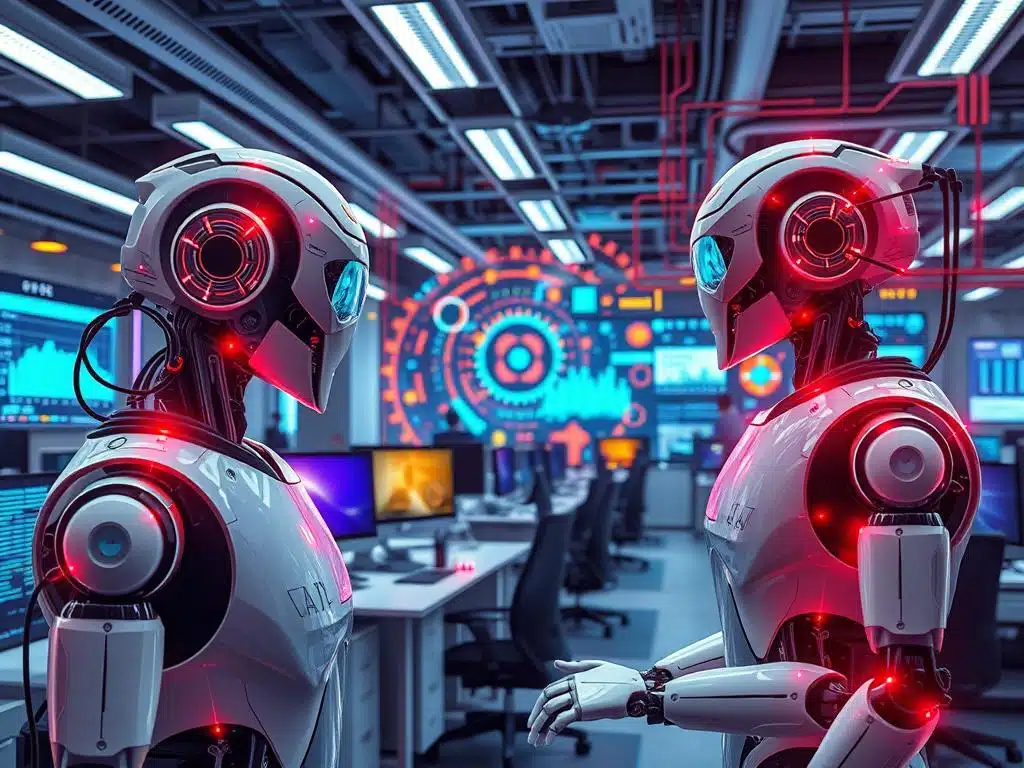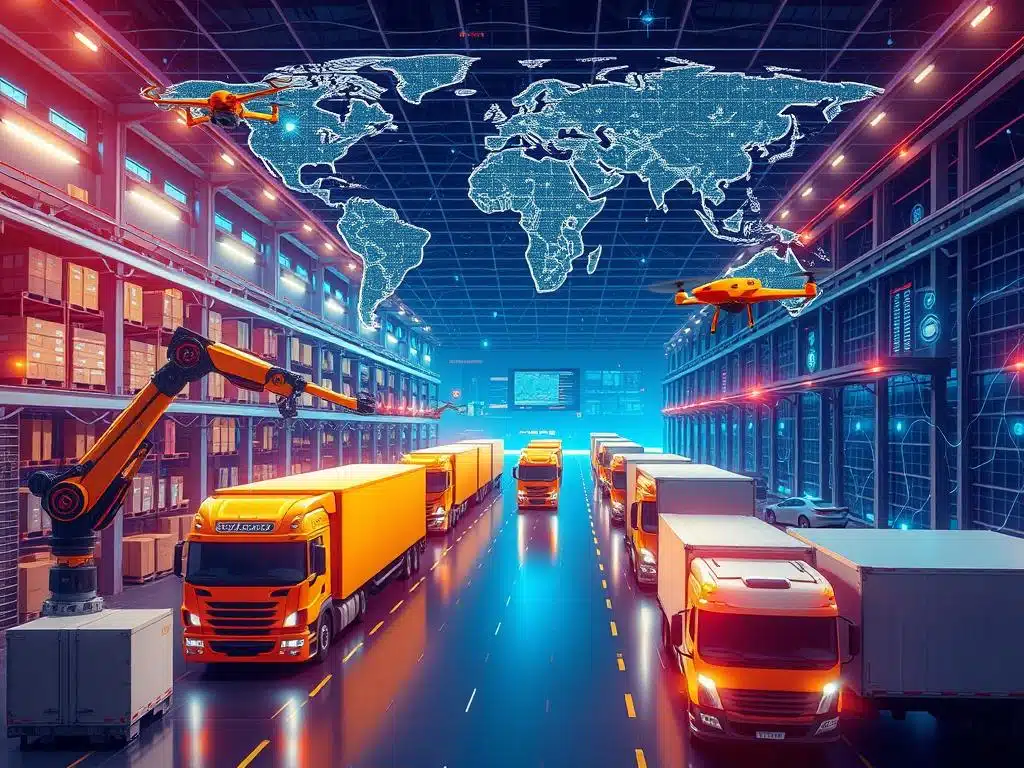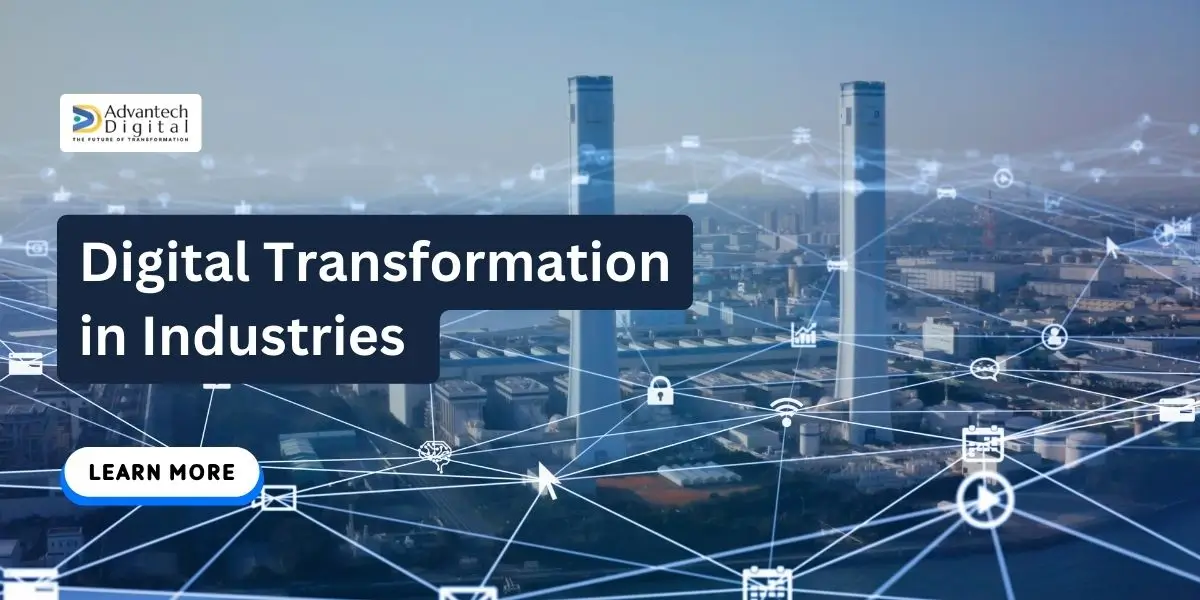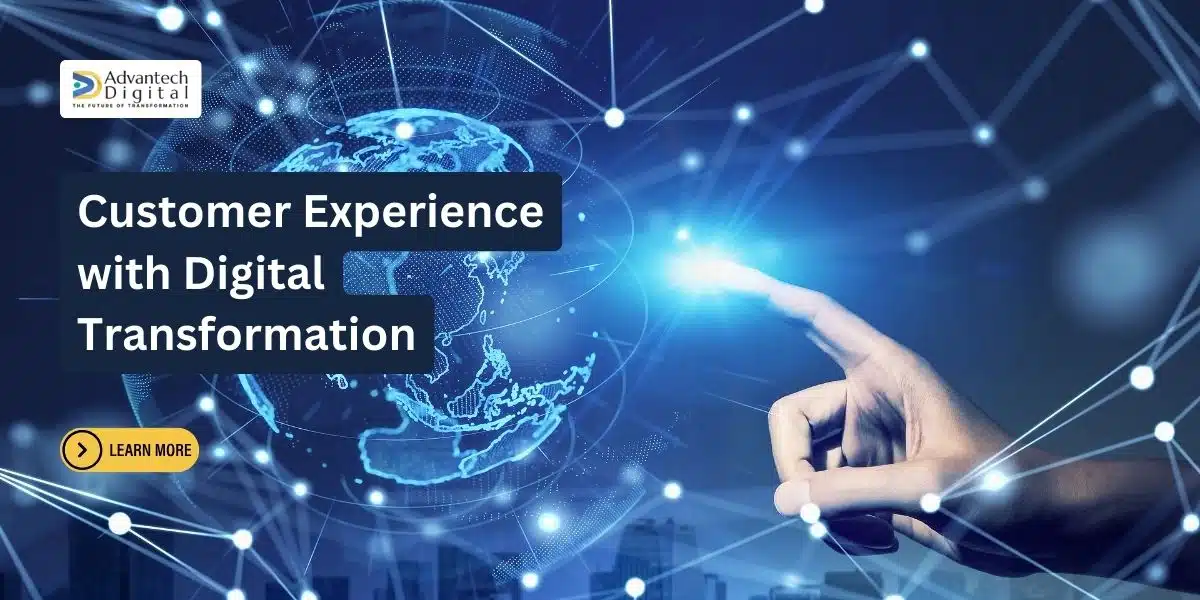The digital transformation revolution is redefining business strategies by 2025. Organizations must adapt to stay competitive in this rapidly changing landscape. Let’s explore the critical digital transformation goals and objectives shaping the future of digital transformation.
Businesses will focus on integrating generative AI and developing sustainable economies. They’ll embrace hyperautomation and prioritize customer experience. Building resilience, leveraging AI, and unlocking IoT potential are also key trends.
Companies can thrive by aligning their digital transformation goals and objectives with these trends. This approach optimizes processes, drives data-driven decisions, and upskills the workforce for the digital age.
The global digital transformation market is projected to reach USD 1009.8 billion by 2025. Direct investment is expected to hit USD 7 trillion. The market’s CAGR is forecasted at 18% from 2020 to 2023.
Organizations undergoing digital transformation will contribute over 50% of global GDP by 2023. This totals approximately USD 53.3 trillion. Embracing digital transformation is now essential for survival in the competitive market.
70% of organizations prioritize technology to simplify workflows and processes. 51% of digital transformation efforts stem from growth opportunities. Businesses must act swiftly to stay ahead of the curve.
Virtual Reality (VR) and Augmented Reality (AR) are predicted to grow fastest until 2025. Companies can leverage these technologies to unlock new possibilities and drive innovation across industries.
Key Takeaways
- Integrating generative AI into business strategies will enable new possibilities across industries
- Developing sustainable and circular economies will be crucial for reducing waste and minimizing environmental footprint
- Embracing hyperautomation and intelligent enterprises will lead to seamless data flow and optimized processes
- Prioritizing customer experience through AI and data analytics will be the key differentiator in the market
- Leveraging AI and machine learning responsibly while addressing ethical concerns will be essential for success
- Unlocking the potential of IoT and embracing cloud computing will drive digital transformation goals and objectives
Getting Strategic With Generative AI
Generative AI is reshaping digital transformation. Integrating it into business strategies unlocks new possibilities across industries. This approach drives innovation that truly makes a difference.
Recent stats show 98% of organizations see technology as their top transformation lever. 82% specifically highlight generative AI. These numbers underscore generative AI’s importance in shaping business’s future.
Moving Beyond the Hype and Integrating Generative AI into Business Strategy
Effective integration requires understanding business objectives and evaluating data. This includes assessing availability, quality, readiness, and ethical use. A comprehensive approach involves executive leadership, business leaders, and IT teams.
Innovation teams, data analysts, and external partners also play crucial roles. Creating a roadmap for success is essential. This involves prioritizing projects, monitoring progress, and adjusting strategies regularly.
Enabling New Possibilities Across Industries with Generative Tools and Applications
Generative AI tools can transform existing business models. They create growth opportunities in healthcare, manufacturing, and education. These technologies improve complex human interactions and enhance customer experiences.
Only 6% of companies have a robust responsible AI foundation. Embracing generative AI requires prioritizing an innovation culture that values ethical practices.
99% of organizations plan to increase AI investment. Over $50 billion was invested in AI startups in 2023. This signals a bright future for generative AI in business.
Sustainable Business and Circular Economies
Businesses are focusing on sustainable practices and circular economies due to environmental concerns. Companies recognize sustainability’s importance in reducing costs and meeting customer demands. Regulatory pressure and changing consumer expectations drive this shift.
Closed-loop systems are crucial for sustainable business practices. These systems minimize waste and reduce environmental impact. Companies can optimize equipment usage and extend asset lifespan using AI, machine learning, and data analytics.
87% of business leaders consider digitalization essential for achieving sustainability. Digital transformation technologies help businesses optimize operations and reduce their environmental footprint.
Green business practices are increasingly influencing consumer buying decisions. Unilever aims to halve its environmental impact by 2030. Interface plans to become carbon-negative by 2040. Patagonia encourages clothing repair and reuse through its “Worn Wear” program.
The Role of Digital Transformation in Achieving Sustainability Goals
Digital transformation tools drive innovation and support sustainability efforts. AI frameworks like TensorFlow and PyTorch provide valuable insights. Data analytics platforms such as Tableau and Power BI help optimize operations.
NASA’s Landsat and other satellite remote sensing tools aid businesses in reducing their environmental impact. These technologies enhance operational efficiency and cost-effectiveness while benefiting the environment.
| Company | Sustainability Goal | Digital Transformation Tool |
|---|---|---|
| Unilever | Halve environmental impact by 2030 | AI-powered supply chain optimization |
| Interface | Become carbon-negative by 2040 | IoT sensors for energy monitoring |
| H&M | Invest in recycling technologies | Data analytics for waste reduction |
Smart agriculture platforms optimize irrigation and reduce pesticide use. Ride-sharing platforms facilitate electric vehicle adoption. These innovations showcase the endless possibilities for sustainable business practices.
The 17 Sustainable Development Goals (SDGs) provide a shared blueprint for peace and prosperity, emphasizing societal and environmental progress.
Sustainable business practices and circular economies will shape the global landscape. Companies can contribute to the planet’s well-being by embracing digital transformation. Prioritizing green business practices positions businesses for long-term success in an environmentally conscious world.
Hyperautomation and the Intelligent Enterprise
Hyperautomation is transforming business operations as we approach 2025. It combines AI, machine learning, and automation tools to boost productivity and efficiency across industries.
This technology streamlines processes and enhances organizational performance. It’s becoming essential for survival in today’s competitive business landscape.
By 2026, the hyperautomation software market is expected to reach $1.04 trillion. Businesses are integrating sophisticated AI tools to progress from automation to hyperautomation.
Seamless Data Flow Between Departments Connected by Intelligent Algorithms
Hyperautomation enables smooth data flow between departments in intelligent enterprises. Intelligent algorithms link business units for real-time analysis and prediction. This helps identify challenges and adapt to market changes quickly.
- In financial services, AI-powered algorithms can analyze data for real-time fraud detection.
- In healthcare, hyperautomation aids in patient data management and digitizing records.
- Manufacturing utilizes hyperautomation tools for optimizing supply chains and forecasting demand.
- Retail sectors benefit from AI-powered chatbots that enhance customer support and response times.
Mitigating Technological Risks and Implications for Human Jobs
Organizations must address technological risks and job implications when implementing hyperautomation. Poor data quality and lack of skills can hinder automation efforts. Investment in data management and upskilling is crucial.
Automation aims to enhance human capabilities, not replace jobs. Gartner notes, “Robots in hyperautomation are seen as tools to empower employees, not threats to their jobs.”
Real-world examples demonstrate hyperautomation’s transformative power:
- Airbus SE reduced expense report approval time from weeks to days using AI-based hyperautomation.
- Equinix, Inc. automated accounts payable processes, saving 14,000 hours yearly for their finance team.
- Hyperautomation has improved efficiency and reduced costs in banking and finance regulatory compliance.
Understanding hyperautomation’s impact on jobs and operations is vital for businesses. Leveraging intelligent algorithms and automation tools can boost efficiency and decision-making in future enterprises.
Prioritizing Customer Experience as the Key Differentiator
By 2025, customer experience will be the crucial differentiator in the digital marketplace. Organizations must shed outdated systems to deliver exceptional customer experiences. Prioritizing customer-centricity can unlock new growth opportunities and boost profitability.
The data is convincing: companies excelling in customer experience outperform others by nearly 80%. Furthermore, 84% of companies improving customer experience report increased revenue. Investing in this area is now a strategic necessity for businesses aiming to thrive.
Leveraging AI and Data Analytics for Hyper-Personalization at Scale
AI and data analytics are key to delivering personalized, seamless experiences. These tools analyze vast customer data, revealing insights into preferences and behaviors. This enables companies to tailor offerings to individual customers at scale, fostering loyalty and advocacy.
| Customer Experience Statistic | Percentage |
|---|---|
| Customers who say tailored engagement based on past interactions is very important | 59% |
| Customers who expect companies to understand their needs and expectations | 66% |
| Customers uncomfortable with how companies use their personal data | 57% |
Companies must balance personalization with privacy concerns. While customers expect tailored experiences, they’re wary of personal data use. Businesses that strike this balance will earn customer trust and loyalty in 2025.
Omnichannel Strategies for a Unified Brand Experience
Creating a seamless brand experience across all channels is crucial. Customer interactions should be consistent, whether via app, social media, chatbot, or in-store. Omnichannel strategies that integrate data and systems will be vital for achieving this continuity.
“73% of companies with above-average customer experience perform better financially than their competitors.”
This quote highlights that prioritizing customer experience drives business success. By using AI, data analytics, and omnichannel strategies, companies can stand out. This approach fosters loyalty and advocacy, ultimately driving growth in a competitive marketplace.
Building Resilience in the Age of Uncertainty
Organizations must cultivate resilience to thrive amidst economic uncertainty, market fluctuations, and unexpected disruptions. Business resilience involves understanding risks, adopting agile practices, and leveraging technology to adapt and survive.
Continuous learning and development are crucial aspects of resilience. As technology advances, employees must upskill and stay current. Companies should prioritize learning initiatives, even during tough times.
- Offering free training on AI, data analytics, and other cutting-edge technologies
- Encouraging collaboration with colleagues, mentors, and industry peers for knowledge sharing
- Promoting a positive mindset towards change and being open to feedback

Embracing agile practices is another critical component of resilience. Breaking down roles into constituent tasks allows organizations to adapt quickly to uncertainties. This task-based approach enables companies to create new roles for organizational resilience.
- Identify existing roles impacted by disruption
- Leverage algorithms to generate pathways for transitioning workers
- Identify new talent sources and create innovative roles
Technology plays a significant role in building resilience, particularly in cybersecurity. With increasing reliance on digital systems, organizations must prioritize cybersecurity resilience to protect against cyber threats.
| Statistic | Percentage |
|---|---|
| Singaporeans who believe technology will change their work for the better (PwC study) | 85% |
| Occupations with at least 30% of activities that can be automated (McKinsey Global Institute) | Majority |
Future of work research in the MICE sector aims to provide a clear, granular, and detailed view of the future of work, emphasizing new roles and skill sets required post-digitalization.
Investing in continuous learning, adopting agile practices, and prioritizing cybersecurity resilience help organizations navigate uncertainty. Embracing change, fostering innovation, and empowering employees are key to building a resilient and future-ready organization.
The Rising Importance of AI and Machine Learning
Artificial intelligence (AI) and machine learning are transforming business operations. A staggering 89% of IT decision-makers are exploring or using AI-enabled technologies, up from 72% in 2023. Organizations investing in AI report positive ROI on operational efficiencies (77%) and improved employee productivity (74%).

AI could increase global GDP by $15.7 trillion, or 14%, by 2030. In China, AI-led automation might boost annual GDP growth by 0.8 to 1.4 percentage points. Businesses must harness AI’s power to remain competitive in this rapidly evolving landscape.
Responsible AI and Ethical Concerns
The rise of AI brings opportunities and ethical concerns. Responsible AI practices are essential to respect privacy, eliminate data biases, and prevent misuse of tools like deep fake images. Prioritizing transparency, accountability, and fairness ensures AI serves the greater good without compromising values.
“AI is changing 50% to 60% of how work is done in various companies, according to Gainwell Technologies’ vice president.”
AI for Operational Expense Reduction
AI’s potential to reduce operational expenses (OPEX) is a compelling reason for businesses to invest. By automating processes and enabling data-driven decision-making, AI helps companies streamline operations and boost efficiency. The AI Pulse Survey by EY in July 2024 confirms these tangible benefits.
| AI Application | Impact on Business |
|---|---|
| Process Automation | Streamlined operations and increased efficiency |
| Enhanced Customer Experiences | Improved customer satisfaction and loyalty |
| Risk Management & Fraud Detection | Reduced financial losses and enhanced security |
| Smart Manufacturing & Predictive Maintenance | Optimized production processes and minimized downtime |
| Personalized Employee Engagement | Increased productivity and job satisfaction |
AI and machine learning will continue to play a critical role in shaping the business landscape. By embracing these technologies responsibly, organizations can unlock new levels of efficiency, innovation, and growth. This positions them for success in the coming years.
Unlocking the Potential of the Internet of Things (IoT)
The Internet of Things (IoT) is revolutionizing business operations, offering unprecedented growth and innovation opportunities. By 2025, integrating IoT technologies into digital transformation strategies will be crucial for competitive companies. This shift will reshape the business landscape, driving efficiency and productivity.
IoT’s impact is significant in supply chain and logistics. Smart tracking systems with IoT devices provide real-time product visibility. This transparency helps companies monitor conditions, reduce waste, and optimize operations for maximum efficiency.
Smart Tracking Systems in Supply Chain and Logistics
IoT-based smart tracking systems are transforming supply chain management. Walmart uses IoT to track inventory in real-time, improving customer experiences and streamlining operations. This approach enhances satisfaction and enables data-driven decision-making for operational optimization.
Rolls-Royce employs IoT and data analytics for aircraft engine maintenance. Connected sensors collect data to predict maintenance needs, reducing downtime and ensuring product safety. This proactive approach revolutionizes traditional maintenance practices.
“Security and privacy are critical in the IoT ecosystem for the success of initiatives.”
IoT applications extend beyond business. Barcelona uses IoT sensors to monitor city aspects like traffic, lighting, waste, and air quality. This smart city approach improves energy efficiency, reduces congestion, and enhances residents’ quality of life.
IoT adoption is set to skyrocket. IDC predicts 41.6 billion connected devices globally by 2025. Industrial and automotive equipment will represent the largest market segment. Smart home devices and wearable technology usage will also increase significantly.
Integrating IoT technologies is key for successful digital transformation. Connected devices and data leverage will optimize operations and enhance customer experiences. This approach gives companies a competitive edge in the evolving business landscape.
Embracing the Cloud and Digital Transformation Goals and Objectives
Cloud computing is vital for achieving digital transformation goals in today’s fast-paced digital world. It offers numerous benefits that align with businesses’ strategic visions. Studies show that 87% of organizations will have digital transformation objectives by 2025.
Cloud adoption helps reduce carbon footprints through energy-efficient data centers. This eco-friendly approach contributes to sustainability efforts and meets the demand for environmentally conscious practices. The cloud also allows efficient resource scaling based on demand.

Platform-as-a-Service (PaaS) for Simplified Application Development
PaaS simplifies application development, allowing IT departments to focus on strategic projects. It provides a comprehensive platform with tools, libraries, and services for quick and efficient application creation. PaaS offers seamless scalability, enabling businesses to adapt to changing demands.
This flexibility is crucial for organizations undergoing digital transformation. It allows them to respond swiftly to market dynamics and customer needs without extensive infrastructure management.
Software-as-a-Service (SaaS) for Cost Reduction and Creativity
SaaS has transformed how businesses access and use software applications. It eliminates complex hardware and software purchases, resulting in significant cost savings. This approach allows businesses to allocate resources towards innovative initiatives.
SaaS offers unparalleled flexibility and accessibility, enabling employees to access critical applications from anywhere. This remote accessibility fosters collaboration, productivity, and creativity among teams. SaaS plays a pivotal role in driving agility, efficiency, and innovation.
| Cloud Adoption Trend | Projected Growth by 2025 |
|---|---|
| Private Cloud | 68% |
| Co-Location Services | 57% |
| Hybrid Cloud | 81% |
Cloud adoption is now essential for digital transformation. Projected growth in Private Cloud (68%), Co-Location Services (57%), and Hybrid Cloud (81%) positions organizations to leverage cloud power. These trends drive digital transformation goals and objectives.
Conclusion
Digital transformation trends will continue to shape businesses as we approach 2025. These trends offer challenges and opportunities across industries. Companies can gain a competitive edge by embracing these changes and adapting to the evolving digital landscape.
Success lies in staying proactive and agile. Leveraging generative AI can drive innovation and efficiency. Prioritizing sustainability and circular economies is crucial. Businesses can stand out by enhancing customer experiences through hyper-personalization and omnichannel strategies.
Investing in IoT, cloud computing, and AI-driven automation can streamline processes. These technologies help reduce costs and improve overall productivity. However, a strategic approach to digital transformation is essential.
Aligning initiatives with business goals requires strong leadership and stakeholder buy-in. Fostering a culture of digital adoption and continuous learning is vital. Businesses that successfully embrace digital transformation will be well-positioned to thrive in the coming years.













4 thoughts on “10 Key Digital Transformation Goals and Objectives in 2025”
Comments are closed.